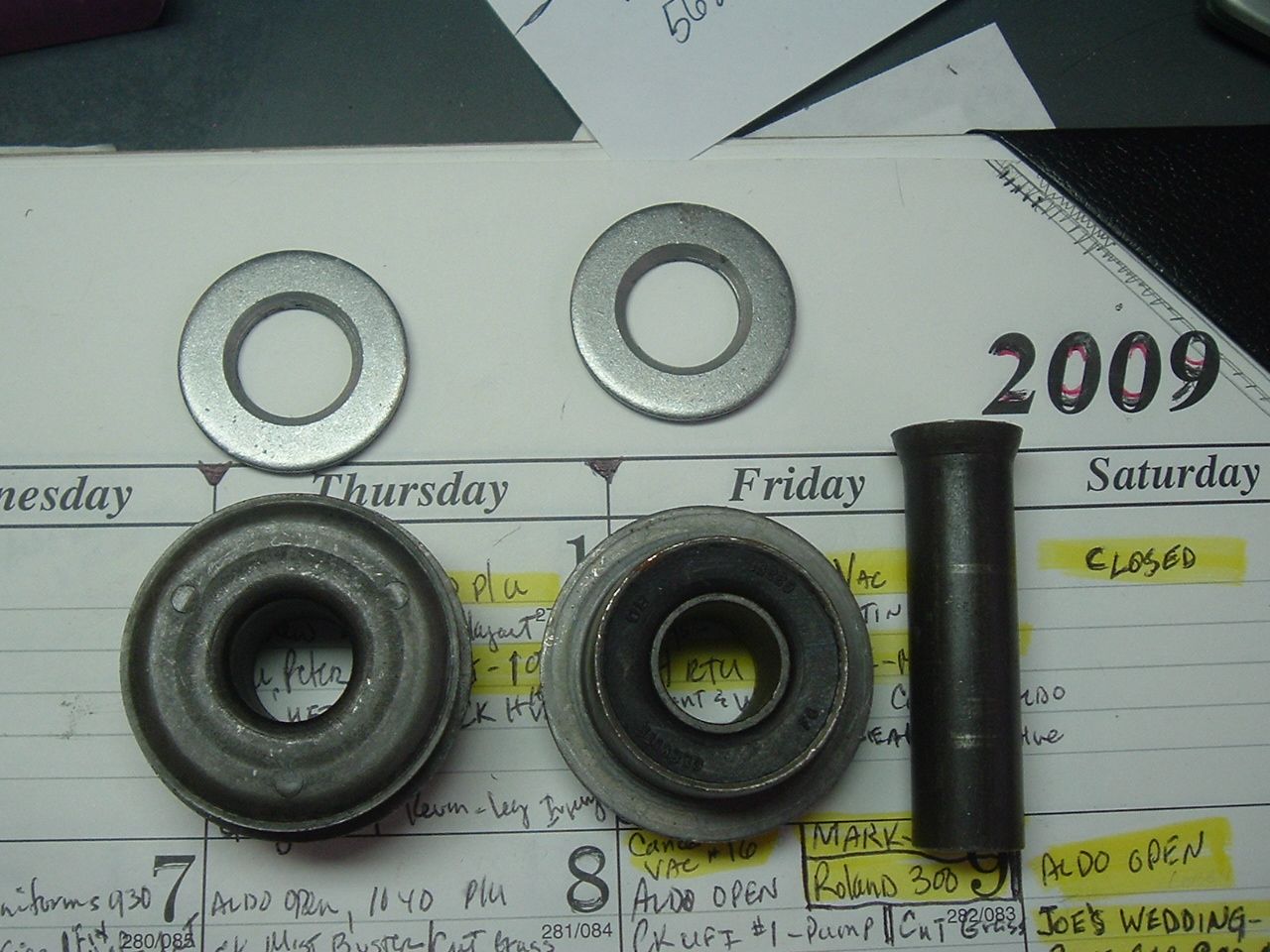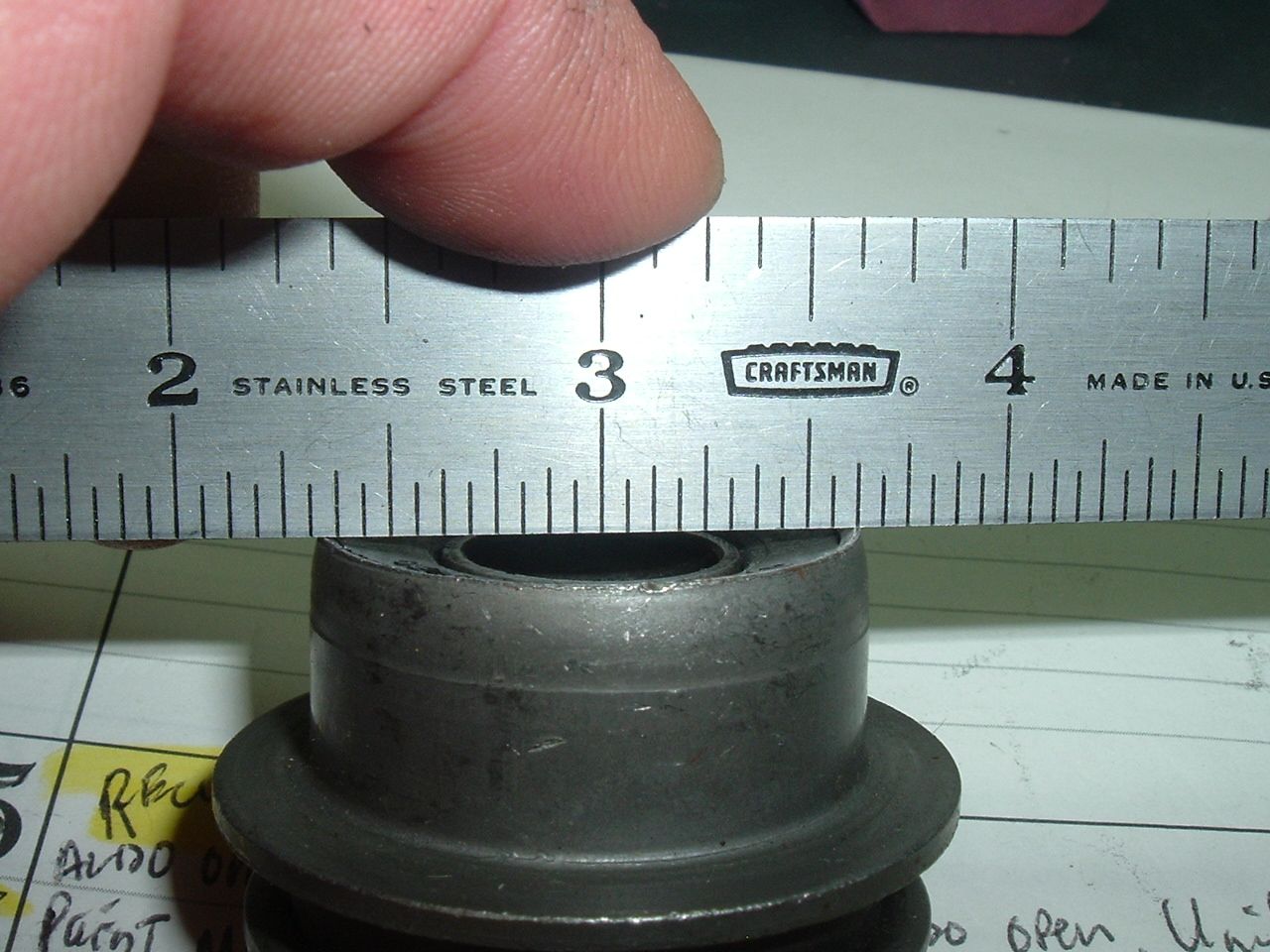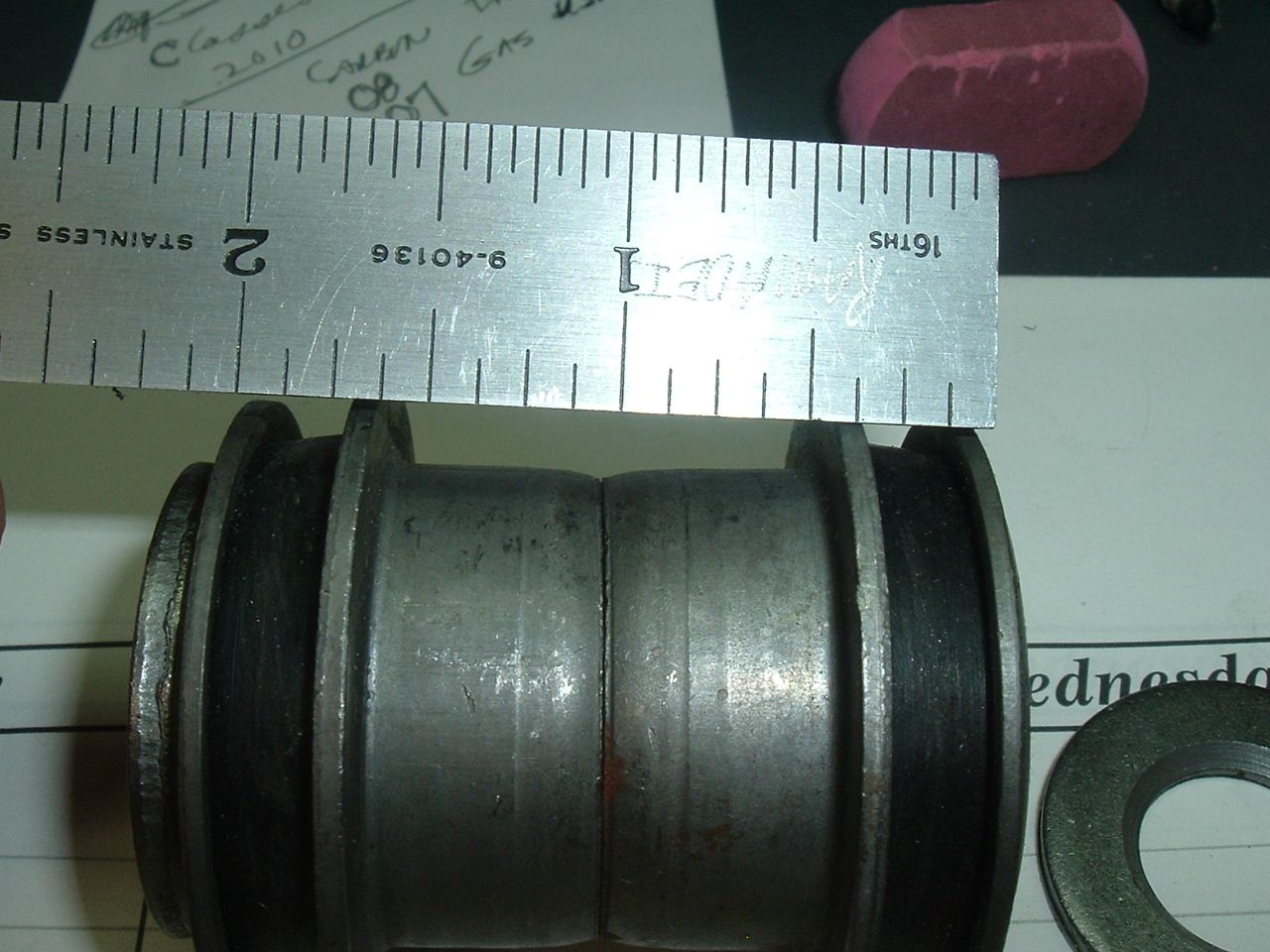66 Rear alignment shims
Collapse
X
-
-
Re: 66 Rear alignment shims
I also agree, those look good. Maybe these pictures will help. These are Clevite bushings.



I don't use those vendor staking tools, I made one from a old die to hold compression to the same tolerance.- Top
Comment
-
Re: 66 Rear alignment shims
PERFECT !! Thanks Gary. You da man. That's exactly what I was looking for. Your 2nd picture shows what I was so desperately trying to describe all along. The inner sleeve is well below the level of the outer sleeve.
That distance, times 2 for the pair, would be the gap between the sleeves when both bushings are installed but before compressing.
I wonder what that dimension is???- Top
Comment
-
Re: 66 Rear alignment shims
Quote: "It is virtually impossible for anyone to discern that the slotted shims have been used after they are installed. If they are tucked down into the frame pocket as they should be, they will not fall out even if no cotter pins are used for retention."
I just wanted to say for flight judging the quote above is incorrect. The original two hole shims are too long as installed to sit down in the frame pocket.
The after market slotted ones are same length but the slot is so deep it allows the shim to sit against the bolt too far in on midyears to look correct. There is also no insurance the slotted shims will stay in place with "fun" driving. The only thing holding them in is a little friction of a deflected frame on each side due to bolt torque, which is not much.
I've seen to many mid year cars loose slotted shims. I only advise their use for alignment setup. Once completed replace with hole shims.- Top
Comment
-
Re: 66 Rear alignment shims
I think most, or likely almost all, of the cases of shims falling out are directly related to improperly compressing the bushings as described (beat to death) above.
I've owned and been around these cars since my first new one in 1964 and "shims falling out" was NOT happening around that time.
This issue is a new one starting in the last 20-30+ years, since guys started replacing these bushings incorrectly during restoration/repair.
I can't even begin to guess how many of these cars I've owned or how many hundreds of thousands of miles I've put on them over the last 45 years without any issue with rear control arm shims falling out.
To recap, again, if the bushings are installed correctly, the shim pack loaded properly and the control arm bolt torqued to specs, the shims will not fall out.
I agree with others that mentioned the minimum point deduction for incorrect shims. I would use the style that tucks in the frame pocket and take the slight point deduction.Last edited by Michael H.; October 27, 2009, 11:32 AM.- Top
Comment
-
Re: 66 Rear alignment shims
Gary-----
The fabricated tool that I think you're referring to here is, I expect, exactly
the tool I was referring to in my "caveat" discussion in my previous post. Using such a tool makes the installation easier and quite precise. I have a friend that's been doing these trailing arms for about 25 years and has supplied most of the shops here in northern California with their rebuilt trailing arms. He's also a good machinist and made up his tool/fixture years ago. He's offered to make me such a tool at no cost, but I turned him down. I told him assuming I ever need to use one again (which is VERY unlikely), I'll just go over and use his. So, I'll probably never use my tools J-8111-23 and J-8880-5 again [but, they're not for sale].
As far as the dimension goes between the end of the center sleeve and end of the outer sleeve goes, I think it varies somewhat. I measured 2 older GM NOS bushings yesterday. The dimension was about 0.042" for each bushing (about 0.084" gap between the 2 bushings butted together). It's neither here-nor-there, though, as the sleeves will be brought together when the bushings are compressed and the retainer flared.In Appreciation of John Hinckley- Top
Comment
-
Re: 66 Rear alignment shims
Wayne-----Wow, We are beating this horse to death here. I'm telling you that any bushing compressed as much as this one, and they actually got the sleeve to flare correctly, will be compressed enough in the center to close the gap in the bushing. There is never any guarantee that the same original shims will fit the hole. I wouldn't worry about it period.
I absolutely and totally agree with everything you said here. In essence, that's what I've been saying, albeit in much "longer form".In Appreciation of John Hinckley- Top
Comment
-
Re: 66 Rear alignment shims
There was a fellow I met in Carlisle that made a tool to flare the bushing after compression. My memory tells me the total (inner and outer) stack of shims being approx 3/4" +- 1/16".
Joe, can you refresh my memory on the lug nut procedure to flare the sleeve you mentioned a long time ago used with a steering wheel puller??
Tim-----
I don't know that I mentioned the use of a steering wheel puller. However, I might have. Most steering wheel pullers are pretty "light duty" for this job. The "lug nut" procedure is, essentially, making up a backing plate with a hole in the center, placing it on one side of the bushing, installing a bolt through the plate and through the bushing retainer, threading a lug nut on the end of the bolt, and using the nut to compress the bushing and flare the retainer. This is a crude but marginally effective tool. The problem is it can be very difficult to flare the retainer since most lug nuts are pretty "soft". I would not use this tool unless there was no other tool available and, for me, there always has been.In Appreciation of John Hinckley- Top
Comment
-
Re: 66 Rear alignment shims
Ok, I assumed you were saying that if the outer sleeves appeared to make contact with each other, the bushing was compressed properly.Ed-----
It's easy to discern if the bushings were compressed enough. Just look at the trailing arm from the forward end. Check for this:
1) The flange of the bushings are fully seated against the outer and inner surfaces of the trailing arm, and:
2) The inner end of the bushing steel shells are contacting one another (or VERY close to contacting one another, maybe 1/32" or less from contact).
If the above conditions exist, bushing compression is not a problem.- Top
Comment
-
Re: 66 Rear alignment shims
Gentlemen, thank you all.
I'll proceed as follows:- I'll assume my bushings are properly pressed. I measure rubber being compressed to .170". Cannot imagine compressing further.
- I will not be concerned with the 1/2" in/out trailing arm play measured at the axle centerline since some of that is a result of the bolt being loose. Also, it's 17" away from the pivot bolt - quite a long lever distance - magifies the play at the bolt.
- I will not be concerned with reinstalling my original shims. I will pack as best as possible (maybe a slight hammer tap is necessary). Rather than attempt to tap in a thin shim, I'll determine shims required, remove a thick one, reinsert a thin one and then tap in the thick one.
- I'll switch to slotted shims so as to minimize shop time expense. Once inserted, shims will be rotated downwards behind chassis wall to prevent accidental falling out.
- Start her up - immediately head to the alignment shop
Thanks again / Ed- Top
Comment
-
Re: 66 Rear alignment shims
Very good, and for the sake of the alignment guy, don't install the cotter pin and don't tighten the nut much. He is going to have to loosen it anyway, why annoy him any more.Gentlemen, thank you all.
I'll proceed as follows:- I'll assume my bushings are properly pressed. I measure rubber being compressed to .170". Cannot imagine compressing further.
- I will not be concerned with the 1/2" in/out trailing arm play measured at the axle centerline since some of that is a result of the bolt being loose. Also, it's 17" away from the pivot bolt - quite a long lever distance - magifies the play at the bolt.
- I will not be concerned with reinstalling my original shims. I will pack as best as possible (maybe a slight hammer tap is necessary). Rather than attempt to tap in a thin shim, I'll determine shims required, remove a thick one, reinsert a thin one and then tap in the thick one.
- I'll switch to slotted shims so as to minimize shop time expense. Once inserted, shims will be rotated downwards behind chassis wall to prevent accidental falling out.
- Start her up - immediately head to the alignment shop
Thanks again / Ed- Top
Comment
Comment